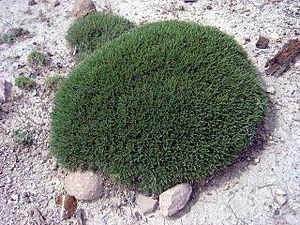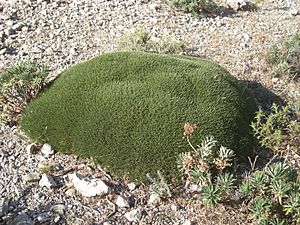Balearic milkvetch facts for kids
Quick facts for kids Balearic milkvetch |
|
|---|---|
 |
|
| Scientific classification | |
| Genus: |
Astragalus
|
| Species: |
balearicus
|
| Synonyms | |
|
Tragacantha balearica (Chater) Romo |
|
Astragalus balearicus, often called the Balearic milkvetch or gatovell, is a unique small plant. It belongs to the legume family, just like peas and beans. You can find this plant growing on the Balearic Islands, which are islands off the coast of Spain.
What it Looks Like
The Balearic milkvetch is a small, round bush with lots of leaves packed together. Its leaves are about 1 to 3 cm (0.39 to 1.2 in) long. Each leaf usually has three to five smaller leaflets.
This plant has pretty flowers that are about 10 and 13 mm (0.39 and 0.51 in) long. They bloom between March and July. After the flowers, it grows small seed pods, called legumes. These pods are smooth and slightly oval, measuring about 7 and 9 mm (0.28 and 0.35 in).
Because of its round, spiky shape, the plant looks a lot like a hedgehog! That's why people sometimes call it eriçóns, which means "hedgehog" in Spanish. It also has other local names, like coixinet de monja (nun's pad) and eixorba-rates negre (black rat).
Its Name and History
The plant Astragalus balearicus was first officially described in 1968 by a scientist named Arthur Oliver Chater. He placed it in the group of plants called Astragalus. This name comes from the Greek word άστράγαλος.
Chater gave it the name balearicus because it grows mainly on the Balearic Islands. This plant is quite similar to another plant called Astragalus massiliensis, which grows in Sardinia. Scientists believe these two plants probably became different species a very long time ago, when the islands separated from mainland France.
Where it Grows
This special legume grows only on the islands of Mallorca and Minorca in the Mediterranean Sea. The plant's cushion-like, spiky shape helps create a unique landscape on these islands. You can find many of these plants in the Serra de Tramuntana mountains.
The Balearic milkvetch likes to grow on limestone soils that are more than 1,000 metres (3,300 ft) above sea level. It prefers places that are dry, windy, and very exposed, like mountains or coastal areas. It needs deep, chalky soils to grow well. You might find it growing alongside other plants like Paeonia cambessedesii.
Good news! The Astragalus balearicus is not considered to be in danger. The IUCN Red List says it is of "Least Concern," which means it's doing well in its natural home.
See also
 In Spanish: Coixinet de monja para niños
In Spanish: Coixinet de monja para niños


